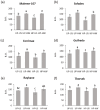Exploring the Genotoxic Stress Response in Primed Orphan Legume Seeds Challenged with Heat Stress
- PMID: 40004564
- PMCID: PMC11855731
- DOI: 10.3390/genes16020235
Exploring the Genotoxic Stress Response in Primed Orphan Legume Seeds Challenged with Heat Stress
Abstract
Background/objectives: The increased frequency of extreme weather events related to climate change, including the occurrence of extreme temperatures, severely affects crop yields, impairing global food security. Heat stress resulting from temperatures above 30 °C is associated with poor germination performance and stand establishment. The combination of climate-resilient crop genotypes and tailored seed priming treatments might represent a reliable strategy to overcome such drawbacks. This work explores the potential of hydropriming as a tool to mitigate the heat-stress-mediated impact on germination performance in orphan legumes.
Methods: For each tested species (Lathyrus sativus L., Pisum sativum var. arvense and Trigonella foenum-graecum L.), two accessions were investigated. Germination tests were performed at 25 °C, 30 °C, 35 °C and 40 °C to assess the heat stress tolerance threshold. Hydropriming was then applied and germination tests were performed at 40 °C to test the impact of the treatment on the seeds' ability to cope with heat stress. An alkaline comet assay and Quantitative Real Time-Polymerase Chain Reaction were performed on embryos excised from primed and control seeds.
Results: Phenotyping at the germination and seedling development stage highlighted the accession-specific beneficial impact of hydropriming under heat stress conditions. In L. sativus seeds, the alkaline comet assay revealed the dynamics of heat stress-induced DNA damage accumulation, as well as the repair patterns promoted by hydropriming. The expression patterns of genes involved in DNA repair and antioxidant response were consistently responsive to the hydropriming and heat wave conditions in L. sativus accessions.
Keywords: Lathyrus sativus L.; Pisum sativum var. arvense; Trigonella foenum-graecum L.; comet assay; heat stress; hydropriming; seed germination.
Conflict of interest statement
The authors declare no conflicts of interest.
Figures










Similar articles
-
Hydropriming and Biopriming Improve Medicago truncatula Seed Germination and Upregulate DNA Repair and Antioxidant Genes.Genes (Basel). 2020 Feb 25;11(3):242. doi: 10.3390/genes11030242. Genes (Basel). 2020. PMID: 32106615 Free PMC article.
-
Impact of priming on seed germination, seedling growth and gene expression in common vetch under salinity stress.Cell Mol Biol (Noisy-le-grand). 2019 Mar 29;65(3):18-24. Cell Mol Biol (Noisy-le-grand). 2019. PMID: 30942152
-
Cytokinins and Expression of SWEET, SUT, CWINV and AAP Genes Increase as Pea Seeds Germinate.Int J Mol Sci. 2016 Dec 1;17(12):2013. doi: 10.3390/ijms17122013. Int J Mol Sci. 2016. PMID: 27916945 Free PMC article.
-
Seed priming and abiotic stress tolerance in carrot: Unraveling the mechanisms of improved germination.PLoS One. 2025 Feb 7;20(2):e0318753. doi: 10.1371/journal.pone.0318753. eCollection 2025. PLoS One. 2025. PMID: 39919063 Free PMC article.
-
Seed germination and vigor: ensuring crop sustainability in a changing climate.Heredity (Edinb). 2022 Jun;128(6):450-459. doi: 10.1038/s41437-022-00497-2. Epub 2022 Jan 10. Heredity (Edinb). 2022. PMID: 35013549 Free PMC article. Review.
References
-
- Lamichaney A., Parihar A.K., Hazra K.K., Dixit G.P., Katiyar P.K., Singh D., Singh A.K., Kumar N., Singh N.P. Untangling the influence of heat stress on crop phenology, seed set, seed weight, and germination in field pea (Pisum sativum L.) Front. Plant Sci. 2021;12:635868. doi: 10.3389/fpls.2021.635868. - DOI - PMC - PubMed
MeSH terms
Grants and funding
LinkOut - more resources
Full Text Sources

